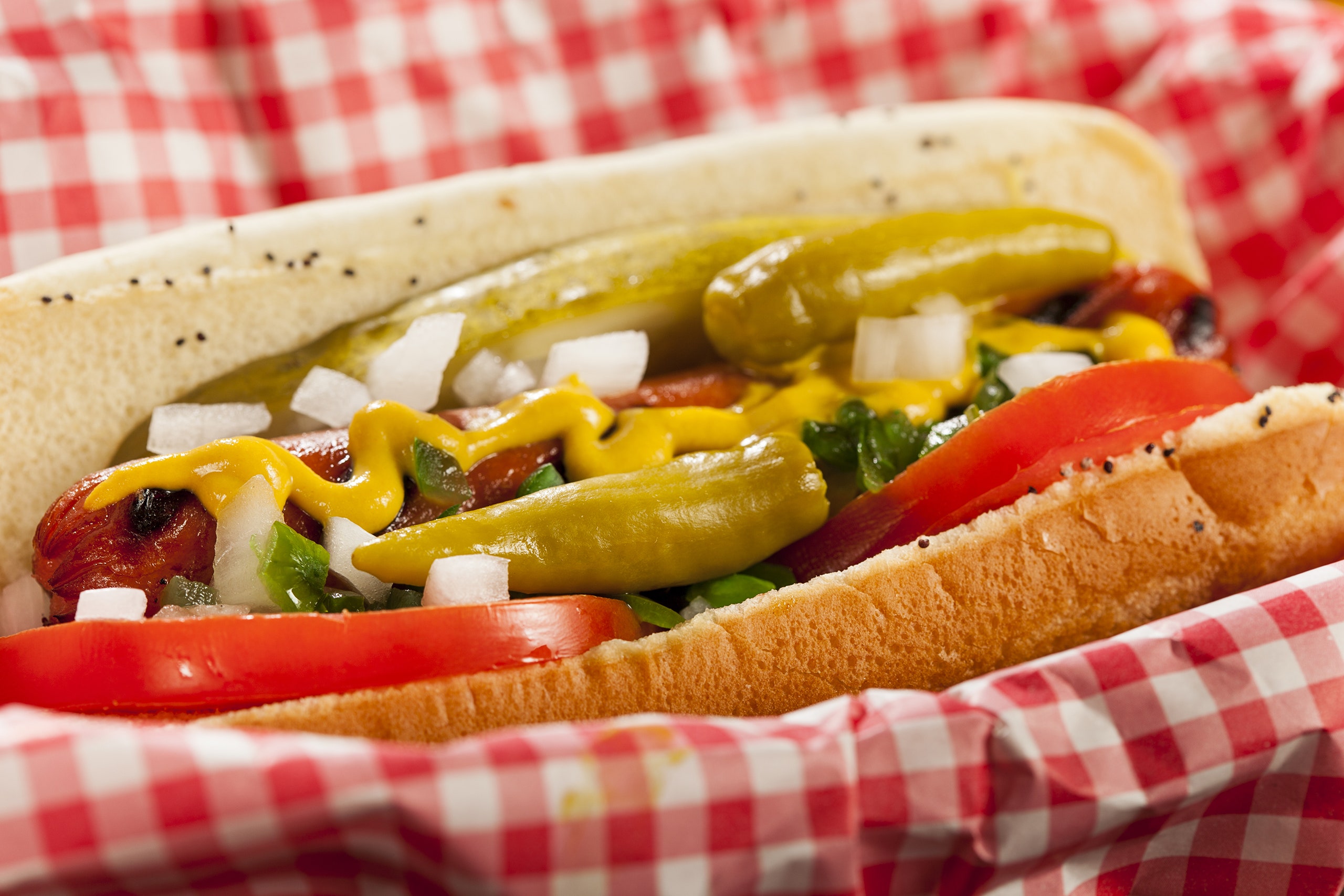- Feb 5, 2002
- 182,564
- 66,117
- Country
- United States
- Gender
- Female
- Faith
- Catholic
- Marital Status
- Married
- Politics
- US-Others
In the Windy City, brook no compromises. Everywhere else, work with what you’ve got.

A Chicago dog features a dill-pickle spear laid parallel to the sausage, red arcs of fresh tomato scalloping the length of the bun, sport peppers nestled on top like green torpedoes, and a sprinkling of celery salt.
People will tell you that the one unbreakable rule of a true Chicago-style hot dog is that it should never, ever have ketchup on it. No ketchup on the premises, within a city block, within nineteen miles—no ketchup even by the existentially accommodating standards of a Noël Coward Martini, wherein a glass of gin is waved in the general direction of Italy. I tell you this as a born-and-bred Chicagoan: those people are wrong. “No ketchup” is not the one unbreakable rule of a true “dragged through the garden” Chicago-style hot dog, and this is because a true Chicago-style hot dog has at least a dozen unbreakable rules, involving nine exactingly specific ingredients, particular methods of preparation, and the precise order of assembly. The final rule is, more or less: the hot dog contains all of these elements, and no more. Ketchup is simply irrelevant.
The Chicago dog was a product of the Great Depression, when venders at the city’s Maxwell Street Market bulked out meagre sausage sandwiches with a dramatic pile of relatively cheap vegetables. Like any other hot dog, it was an affordable meal, fast to prepare and fast to eat, that appealed to Chicago’s working-class population. Over time, this food of convenience evolved into a holy cultural object, until the act of building a proper Chicago dog demanded a degree of attention and care that verged on the liturgical. Among the devout, none of the dog’s nine individual elements is unimportant, and any deviation amounts to sacrilege. The bun is steamed, never toasted, and must come bedecked with poppy seeds. The sausage is boiled or steamed, not grilled, and all-beef, never a blend. Color is key: the mustard should be crayon yellow; the sweet-pickle relish a shocking, supernatural neon green; the minced onions, snow white. You can stop here and hold in your hands a perfectly passable, generic cookout dog—or continue on toward Chicago-style paradise: a dill-pickle spear laid parallel to the sausage; red arcs of fresh tomato scalloping the length of the bun; tiny pickled sport peppers (which are medium-hot and about an inch long; there is no other acceptable variety) nestled on top like green torpedoes; and, as a final flourish, a sprinkling of celery salt. Finesse matters: a Chicago-style hot dog is an aesthetic creation as much as a culinary one. A careful assemblage of squiggles, dots, and half-moons, of soft contours juxtaposed with sharp geometries, it looks a bit like a nineteen-eighties Memphis Group masterpiece. Lunch, as prepared by Ettore Sottsass.
Continued below.
The Unbreakable Rules of the Chicago Dog—and When to Bend Them

A Chicago dog features a dill-pickle spear laid parallel to the sausage, red arcs of fresh tomato scalloping the length of the bun, sport peppers nestled on top like green torpedoes, and a sprinkling of celery salt.
People will tell you that the one unbreakable rule of a true Chicago-style hot dog is that it should never, ever have ketchup on it. No ketchup on the premises, within a city block, within nineteen miles—no ketchup even by the existentially accommodating standards of a Noël Coward Martini, wherein a glass of gin is waved in the general direction of Italy. I tell you this as a born-and-bred Chicagoan: those people are wrong. “No ketchup” is not the one unbreakable rule of a true “dragged through the garden” Chicago-style hot dog, and this is because a true Chicago-style hot dog has at least a dozen unbreakable rules, involving nine exactingly specific ingredients, particular methods of preparation, and the precise order of assembly. The final rule is, more or less: the hot dog contains all of these elements, and no more. Ketchup is simply irrelevant.
The Chicago dog was a product of the Great Depression, when venders at the city’s Maxwell Street Market bulked out meagre sausage sandwiches with a dramatic pile of relatively cheap vegetables. Like any other hot dog, it was an affordable meal, fast to prepare and fast to eat, that appealed to Chicago’s working-class population. Over time, this food of convenience evolved into a holy cultural object, until the act of building a proper Chicago dog demanded a degree of attention and care that verged on the liturgical. Among the devout, none of the dog’s nine individual elements is unimportant, and any deviation amounts to sacrilege. The bun is steamed, never toasted, and must come bedecked with poppy seeds. The sausage is boiled or steamed, not grilled, and all-beef, never a blend. Color is key: the mustard should be crayon yellow; the sweet-pickle relish a shocking, supernatural neon green; the minced onions, snow white. You can stop here and hold in your hands a perfectly passable, generic cookout dog—or continue on toward Chicago-style paradise: a dill-pickle spear laid parallel to the sausage; red arcs of fresh tomato scalloping the length of the bun; tiny pickled sport peppers (which are medium-hot and about an inch long; there is no other acceptable variety) nestled on top like green torpedoes; and, as a final flourish, a sprinkling of celery salt. Finesse matters: a Chicago-style hot dog is an aesthetic creation as much as a culinary one. A careful assemblage of squiggles, dots, and half-moons, of soft contours juxtaposed with sharp geometries, it looks a bit like a nineteen-eighties Memphis Group masterpiece. Lunch, as prepared by Ettore Sottsass.
Continued below.
The Unbreakable Rules of the Chicago Dog—and When to Bend Them
